Sun activity for July 31, 2023: The final plunge of a sun-diving comet
Watch a comet take its final plunge into the sun in the image above. Just before a coronal mass ejection (CME) left the sun’s southwest limb (edge), a small, bright, teardrop-shaped object can be seen traveling toward the direction of the erupting plasma. This was a small comet, called a sungrazer. The icy rock has a teardrop shape because the sun’s light and solar wind are evaporating its mass and dragging the cometary material outward, in the form of a tail. The comet fades as it gets closer to the sun, eventually disappearing, evaporating into the solar corona. Meanwhile, here on Earth, space weather forecasters are expecting the arrival of a CME from July 28 early on August 1, 2023. G1 (Minor) to G2 (Moderate) geomagnetic storms are expected. Stay tuned for updates and possible aurora sightings from northern latitudes. Details below, under “Current geomagnetic activity.”
Last 24 hours: Sun activity is moderate. During the past day, there were seven flares – one M and six C flares – between 11 UTC yesterday and 11 UTC today. The largest event was an M1.9 at 8:42 UTC on July 31 from AR3390. The event produced an R1 (minor) radio blackout which affected an area over Africa. A filament eruption produced a CME off the southwest limb first observed in LASCO C2 at 17:18 UTC on July 30, 2023. We await further analysis to determine if there is an Earth-directed component.

Sun activity for July 30, 2023: Where did the sun go?
Because of the orbit of NASA’s Solar Dynamics Observatory’s ( SDO), the Earth or moon can sometimes pass in front of the sun as seen from the spacecraft. And that’s what happened in the image above. Not a glitch! An eclipse of the sun by the Earth! Of course, the satellite is designed to maximize the amount of time it can observe the sun. But there are still be a few times when SDO’s view is blocked, sometimes by Earth and sometimes by the moon. When we see the moon move in front of the sun, the edges are sharp because the moon has no atmosphere. When Earth photobombs the sun, the edge is fuzzy because of Earth’s atmosphere. The current SDO eclipse season started on July 20 and ends on August 16, 2023. By the way, we’re expecting a solar storm. See Current Geomagnetic Activity, below.
Last 24 hours: Sun activity is moderate. During the past day, there were 10 flares – three M and seven C flares – between 11 UTC yesterday and 11 UTC today. AR3390 produced the most flares with two M and two C. The two additional M flares were an M1.4 at 16:11 UTC from AR3380 and an M1.8 at 8:01 UTC from AR3390. The largest event was an M1.9 at 8:18 UTC on July 30 from AR3390. The event produced an R1 (minor) radio blackout which affected an area over Africa. Meanwhile, solar particles from the July 28 M4.1 flare event are still impacting Earth at the S1 radiation storm level. This is limiting certain radio communication bands around the north pole during what is call a polar cap absorption (PCA) event. The sun today has 10 numbered active regions, with new region AR3391 on the SE limb (edge).

Sun activity for July 29, 2023: Huge explosion beyond the northwest limb
A huge eruption took place on the northwest limb (edge). It occurred just over the limb from the now departed region AR3372. And it produced an M4.1 flare at 15:58 UTC on July 28. Actually, because the region was partially blocked by the sun, it was most certainly larger than an M4.1. It launched a beautiful coronal mass ejection (CME) and shortly afterward a solar particle storm. Due to its position over the limb (edge), the CME is probably not Earth-directed. But it is still under analysis. In addition, a filament erupted in the northeast around 20:30 UTC on July 28. The dark material ejected indicates that the erupting material was cooler than its surrounding. The event is under analysis to determine if there is an Earth-directed component.
Last 24 hours: Sun activity is moderate. During the past day, there were 11 flares – one M and 10 C flares – between 11 UTC yesterday and 11 UTC today. The largest and only M flare was an M4.1 at 15:52 UTC on July 28 from AR3372. Besides, the event produced an R1 (minor) radio blackout which affected an area over the east coast of Puerto Rico. It also produced a bright coronal mass ejection (CME) and a solar particle storm at the S2 level. The solar particles reached the storm level at 17:45 UTC on July 28. AR3390 is the lead producer of the period with three C class flares. The sun today has 10 numbered active regions with a newcomer, AR3390, on the southeast limb (edge).
Sun activity for July 28, 2023: Newcomer AR3388 salutes AR3376’s departure
Sun activity remains moderate after an M1.8 flare from newcomer AR3388. AR3376, the most active sunspot today and during the past week, has just rotated out of view. An active east limb (edge) is coming our way, with three newcomers: AR3387, AR3388, and AR3389. Will one of these regions continue where AR3376 left off? AR3388 is off to a good start, making its presence known with the only M flare of the past day. SOHO‘s LASCO C3 instrument registered a big coronal mass ejection (CME) at around 0:06 UTC in the northeast. No flare has been associated with the blast, indicating that it occurred on the sun’s far side, so no CME is headed our way.
Last 24 hours: Sun activity is moderate. The sun produced one M and 17 C flares between 11 UTC yesterday and 11 UTC today. The largest and only M flare was an M1.8 at 22:34 UTC on July 27 from AR3388. The event produced an R1 (minor) radio blackout which affected an area over Hawaii. AR3376 remained the lead producer until its departure from the Earth-facing disk, producing 12 of the day’s 17 C flares. The sun today has ten numbered active regions, including three newcomers: AR3387 on the northeast quadrant, and AR3388 and AR3389 in the southeast.
Sun activity for July 27, 2023: Back-to-back M flares from AR3376
Sun activity continues at moderate levels. Flare production increased to 24 flares during the past day. Sunspot AR3376 gave us a one, two punch of M flares and then another M at the end of our observation window. AR3377 continues to produce small jets, filament eruptions and coronal mass ejections (CMEs). It has been active during most of its transit across the sun. It will soon rotate out of view. The sigmoid or ‘S’ shaped filament persists across the northeast disk. Stay tuned for more action from our star.
Last 24 hours: Sun activity is moderate. During the past day, the sun produced 24 flares, three Ms and 21 Cs between 11 UTC yesterday and 11 UTC today. The first and largest M was an M2.0 flare at 15:59 UTC followed by an M1.1 at 16:13 UTC both on July 26. The last flare of the this observing period was an M1.9 at 9:48 UTC on July 26. All the M flares came from AR3376. The first two M flares produced R1 (minor) radio blackouts affecting an area over the east coast in Puerto Rico with the last one over south Egypt and the Red Sea. The lead flare producer was AR3376 with 16 flares including the three Ms. The sun has ten numbered active regions. We have two newcomers, AR3385 on the southwest quadrant and AR3386 on the northeast limb (edge).
Sun activity for July 26, 2023: Minor geomagnetic storm… and more coming!
A G1 (minor) geomagnetic storm occured earlier today. The long-awaited storm arrived early in the form of a shock wave, causing the geomagnetic field to reach the G1 (KP = 5) threshold at 0:01 UTC. The threshold was reached again at 5:09 UTC, and there’s probably more to come. NOAA forecasters have issued a G1 alert, and anticipate more G1 conditions through the rest of the day and tomorrow. All of this means … auroras! Aurora chasers, get your cameras out and polish your lenses. Turning to the sun itself, we observed what appeared to be a double M1.6 flare at around 21:16 UTC on July 25. AR3380 and AR3376 both flashed at almost exactly the same time from the southeast and northwest of the sun, respectively. While it looked like the flare came from both regions, it was not really a double flare; the peak flash came from AR3380.
Last 24 hours: Sun activity remains moderate, but flaring production is increasing. We saw a total of 19 flares between 11 UTC yesterday and 11 UTC today, with three M flares and 16 Cs. The largest event was an M4.6 at 10:17 UTC on July 26 from AR3376. The next largest was the M1.6 from AR3380 at 21:16 UTC on July 25. The last was an M1.2 flare at 4:28 UTC on July 27 from AR3376. Shortly after each M flare, a corresponding R1 (minor) radio blackout was observed. The first affected an area over Africa, the second an area off the west coast of Mexico, and the third occurred over Laos. The leading flare producer of the period was AR3376 with eight flares. The sun currently has nine numbered active regions, including newcomer AR3384 on the southeast limb (edge).
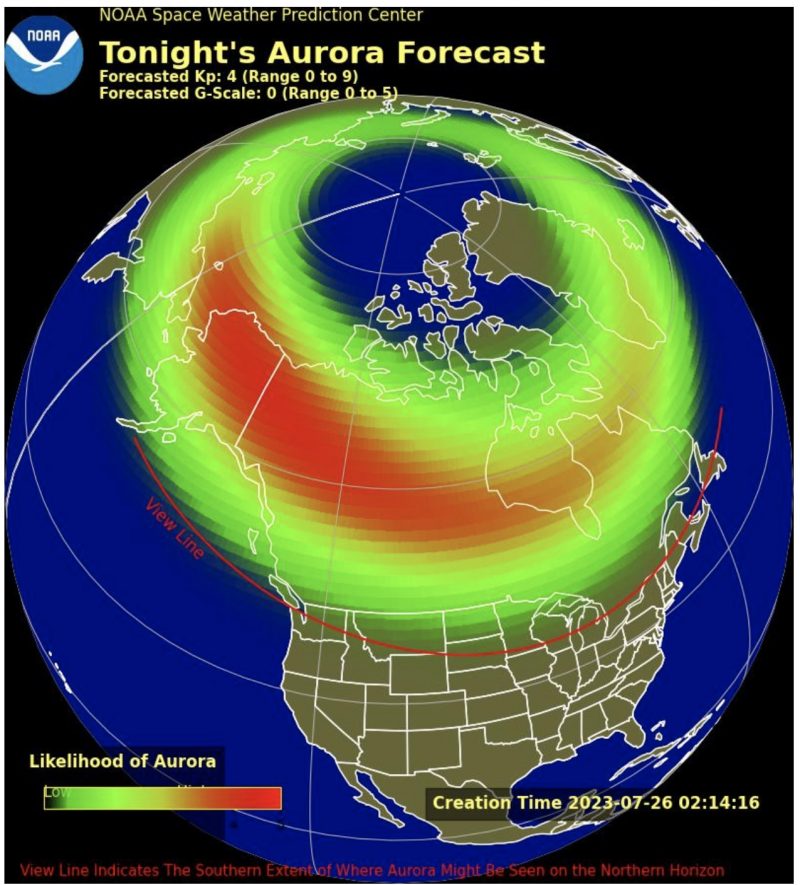
Sun activity for July 25, 2023: M flare and a full-halo CME
Sun activity is moderate, with the production of an isolated M1.5 flare by AR3376 on July 25. Although this sunspot region is now located close to the northwest limb (edge), the resulting coronal mass ejection (CME) is still being modeled to check for any Earth-directed component. SOHO‘s LASCO C3 instruments registered an asymmetric full-halo CME around 18:00 UTC on July 24, with more of its mass located in the southwest. No corresponding flare was observed on the Earth-facing side of the sun, meaning it was a back-sided event. During the past day we also observed several jets and small eruptions in the vicinity of AR3377, which sent faint CMEs into space.
Last 24 hours: Sun activity is moderate, with the production of an M1.5 flare at 2:03 UTC from AR3376 on July 25. The sun also produced 11 C flares between 11 UTC yesterday and 11 UTC today. Shortly after the M flare, an R1 (minor) radio blackout occurred over the Philippine Sea east of Taiwan. The lead flare producer of the period was AR3373 with five C flares. The sun currently has nine numbered active regions. Three are newcomers: AR3381, AR3382 and AR3383.
Sun activity for July 24, 2023: CME glancing blow headed our way
Sun activity is low, with only C flares today. During this overall lull in activity the sun did throw a coronal mass ejection partially our way. The CME was associated with a C5.2 flare from AR3376 on July 23, 2023. This event off the sun’s northwest limb (edge) – combined with the first filament eruption of yesterday – are expected to provide Earth with a glancing blow midday July 27, 2023. Otherwise, the sun was quiet without even any significant filament or prominence eruptions. Meanwhile, helioseismology is showing some potentially large sunspot activity on the sun’s far side. Time will tell.
Last 24 hours: Sun activity is back at low levels. The sun produced 13 C flares during the past day between 11 UTC yesterday and 11 UTC today. The largest was a C9.1 from sunspot region AR3373 at 3:08 UTC on July 24, 2023. The sun currently has seven numbered active regions on its Earth-facing side.
Sun activity for July 23, 2023: Beautiful prominence, 2 exploding filaments
Sun activity is low with the production of only six C flares during the past day. There have been low flare levels, overall. Peaks of intense activity followed by a calm will continue as we approach to the peak of Solar Cycle 25. It is normal for sun activity to slow down after a few days of high activity. Nevertheless, the sun granted us with a gorgeous prominence close to its north pole. One of these long-lasting prominences dancing in the vicinity of north polar region detached and hurled a coronal mass ejection into space. But the CME was too far north to come our way at Earth. On the other hand, a couple of filament eruptions were observed on the solar northeast quadrant. The first occurred at around 14 UTC on July 22, 2023 above the sigmoid structure on the trans-equatorial long filament we reported yesterday. Shortly afterwards, a second exploding filament occurred in the vicinity of sunspot region AR3379. Coronal mass ejections (CMEs) were observed to be hurled into space during the events. Modeling and analysis of the ejecta is still undergoing to find any component coming our way at Earth. Stay with us.
Last 24 hours: Sun activity is back at low levels. The sun produced only six C class flares during the past day between 11 UTC yesterday and 11 UTC today. The largest was a C9.9 exploded at 04:54 UTC by AR3373 on July 23, 2023. AR3373 share places with AR3372 as both blasted two C flares during the period. The sun currently shows six numbered active regions on its side view from Earth.
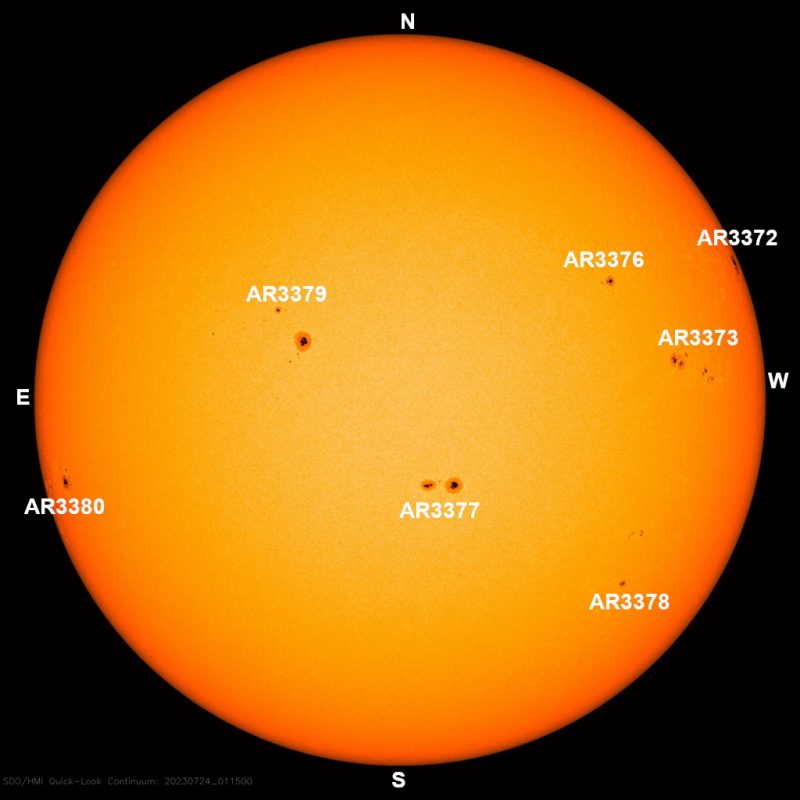
Sun activity for July 22, 2023: Weak CME arrival on Earth, 2 M flares on the sun
The coronal mass ejection (CME) arrival that we anticipated yesterday resulted only in a weak unsettling of Earth’s magnetic field. Like the first CME arrival yesterday, this second impact brought geomagnetic disturbance at a Kp = 4 level (a step lower than the lowest threshold on the NOAA scale). Turning back to the sun, it was looking like a calm day with only five C flares … but then, BAM BAM! A couple of M flares were fired on the northwest quadrant. The culprits were sunspots AR3372 and AR3372. Elsewhere, we observed a trans-equatorial long filament – take a look at the imagery below. When a similar long filament exploded earlier this year, it provoked high levels of magnetic disturbance on Earth, so this one is worth keeping an eye on!
Last 24 hours: Sun activity is moderate, with the production of two M flares between 11 UTC yesterday and 11 UTC today. The largest was an M3.2, exploded by sunspot AR3372 at 3:37 UTC, July 22. The second was an M1.0 by AR3373 at 4:16 UTC, July 22. Flaring productivity is low with a total of just seven flares: five Cs and the two Ms. Both M flares provoked a corresponding R1 (minor) radio blackout. The M3.2 flare’s blackout affected an area over Okinawa Island in Japan, while the M1.0 affected an area over the south coast of China. AR3373 produced three flares during the period, making it the lead flare producer of the day. This region is now not only the largest, but the most magnetically complex region, having developed a beta-gamma-delta configuration. This configuration means this it has the potential for more M flares and even X flares. And, due to its current geoeffective position, any big blast and coronal mass ejection (CME) would come directly our way! The sun currently bears six numbered active regions.
Sun activity for July 21, 2023: CME arrival, geomagnetic storms incoming
Earth’s magnetic field has been hit by a coronal mass ejection (CME) that left the sun on July 17. Levels of magnetic disturbance reached Kp = 4 (not enough to register on the NOAA scale) at 17:08 UTC on July 20. A second CME arrival is anticipated later today, possibly bringing a G1 (minor) geomagnetic storm. This could mean auroral displays in northern latitudes, as well as far down the Southern Hemisphere – aurora chasers, good luck! Share your beautiful photos with us at EarthSky Community Photos. Turning our eyes to SOHO‘s LASCO C3 imagery, we observed an appearance from Pollux, one the brightest stars of the Gemini constellation. Check it out below.
Last 24 hours: Sun activity has come to a rest. Flaring intensity and productivity are both low, with only five C class flares produced between 11 UTC yesterday and 11 UTC today. The largest was a C9.7 from sunspot AR3373 at 19:49 UTC on July 20. Rounded up, this could be considered an M flare, which would have placed sun activity at moderate . But since we saw so few flares, solar activity is considered low. AR3373 and AR3379 are joint-lead flare producers, with two flares each. AR3373 is currently the largest sunspot on the Earth-viewed solar disk, and is now showing a beta-gamma configuration. It has also just reached a geoeffective position, so any major flares and coronal mass ejections (CMEs) by this active region will be directed toward us at Earth. There are currently seven labeled sunspot active regions on the Earth-side of our sun. No newcomers today.
Sun activity for July 20, 2023. Big northwest blast, AR3363 M flaring from afterlife
An enormous explosion on the northwest quadrant in the vicinity of AR3372 occurred at around 22:37 UTC on July 19. The blast was associated with a C3.0 flare from a long filament explosion by an unnumbered region located between AR3372 and the northwest limb (edge). The flare was accompanied by a gorgeous dancing prominence and a coronal mass ejection (CME) that we saw being hurled into space. Initially, specialists found the bulk of the ejecta too far north to be Earth-directed. Modeling and analysis, however, will continue as soon as coronagraph imagery is available. Almost simultaneously with the eye-catching blast, a filament on the southwest sent a jet of plasma hurtling into space. It was fairly large, but compared with the huge explosion and prominence, it looks quite small! In the meantime, our departed hero AR3363 is still throwing out M flares. It has already rotated beyond the solar southwest horizon, but is continuing to produce registered M flares. Even larger flares could very well be occurring beyond our field of view!
Last 24 hours: Sun activity remains moderate. Between 11 UTC yesterday and 11 UTC today, we observed 14 flares. Two of these were M flares, and the rest were C flares. Both Ms were blasted by sunspot region AR3363 from beyond the solar horizon on the southwest. The first was an M1.4 at 11:07 UTC, July 19, and the second – the largest of the period – was an M3.8 flare that exploded at 17:25 UTC, July 19. Shortly after each M flare, an R1 (minor) radio blackout was registered over Earth’s sunlit northern hemisphere. The lead flare producer is still AR3363, despite having rotated beyond the southwest solar horizon. The sun today bears eight labeled active regions on its Earth-viewed side. Two are newcomers: AR3378 on the southeast quadrant, and AR3379 on the northeast limb (edge).
Sun activity for July 19, 2023, is going strong! 3 Ms and a CME on its way
For the second day in a row, we’ve seen one, two, three M flares in quick succession. This time the back-to-back M flares came from AR3363 and AR3376. The three Ms exploded in the span of less than an hour, with the largest being an M2.1 flare from AR3363 at 20:27 UTC on July 18. Now at the very edge of the southwest limb, giant sunspot AR3363 continues flaring and is, once again, the lead flare producer of the day. What a spot! Today’s other M flare producer, AR3376, is showing an interesting north-south magnetic configuration and an anti-Hale alignment, meaning that its magnetic field is reversed compared to other sunspots in the same solar hemisphere. This may be a factor in its production of M flares, and could be a source for more blasts as AR3376 transits the Earth-viewed side of our sun. We’ll watch closely. By the way, yesterday’s M5.7 flare from AR3363 continues to be the source of discussion. The highly energetic long-duration flare created a polar cap absorption S1 particle event, and a coronal mass ejection (CME) with a partial halo. Despite having occurred far to the southwest, a component of this CME is anticipated to reach us at Earth with a glancing blow on July 20, which may bring G1 (minor) to G2 (moderate) geomagnetic storms and auroral displays. Aurora-chasers, get ready!
Last 24 hours: Solar activity is now considered moderate. Between 11 UTC yesterday and 11 UTC today we observed 17 flares: three Ms and 14 Cs. The first two M flares were produced by AR3376 – an M1.3 at 19:48 UTC and an M1.4 at 20:05 UTC – and the third and largest was an M2.1 flare from AR3363 at 20:27 UTC (all on July 18). After each M blast, an R1 (minor) radio blackout affected an area over the west coast of Mexico by Baja California. The leading flare producer of the period was sunspot AR3363, sitting at the very edge of southwest limb in a foreshortened position that makes it difficult to analyze fully. It produced eight flares, the M included. The sun today bears seven labeled active regions on its Earth-viewed side.
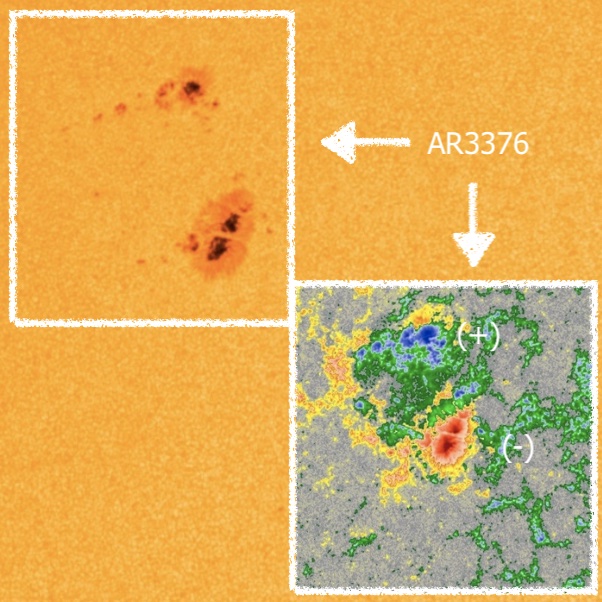
Sun activity for July 18, 2023, is high! At Earth, a geomagnetic storm
AR3363 kicked things into gear at the end of July 17, with three back-to-back M flares. We observed an M2.7, an M5, and finally a long-duration M5.7, strong enough to bring activity levels to high. This long-awaited action from AR3363 comes as it has nearly rotated out of view. The M5.7 produced a spectacular eruption, firing out a coronal mass ejection (CME). The CME is not heading directly for Earth, but NASA’s modeling forecasts a glancing blow on July 20. The location of the eruption is very conducive to a particle event. This is due to the way that the sun’s magnetic field spirals away toward us, like a particle highway providing a direct route from the sun to Earth. An S1 particle storm was measured at the GOES spacecraft. Meanwhile at Earth, the anticipated G1 (minor) geomagnetic storm was observed late on July 17 to early July 18.
Last 24 hours: The production of three back-to-back M flares, one of them surpassing the M5 threshold, has raised the sun activity level to high. Between 11 UTC yesterday and 11 UTC today we observed 17 flares: four Ms and 13 Cs. The largest was an M5.7 flare by sunspot AR3363, blasted at 0:06 UTC on July 18. Here’s the breakdown of the M flares, with all times in UTC:
M2.7 from AR3363 at 22:54 on July 17,
M5.0 from AR3363 at 23:34 on July 17,
M5.7 from AR3363 at 0:06 on July 18, the largest,
M1.5 flare from an unnumbered active region on the northeast limb (edge) at 6:56 on July 18.
Each M flare caused a corresponding radio blackout:
R1 (minor) at 22:57, affecting an area over Hawaii,
R2 (moderate) at 23:34 affecting an area over the Pacific Ocean,
R2 (moderate) at 0:06 affecting an area over the Pacific Ocean,
R1 (minor) at 6:56 affecting an area over India.
The sun currently has eight labeled active regions on its Earth-facing side. Three are newcomers: AR3375, AR3376, and AR3377.

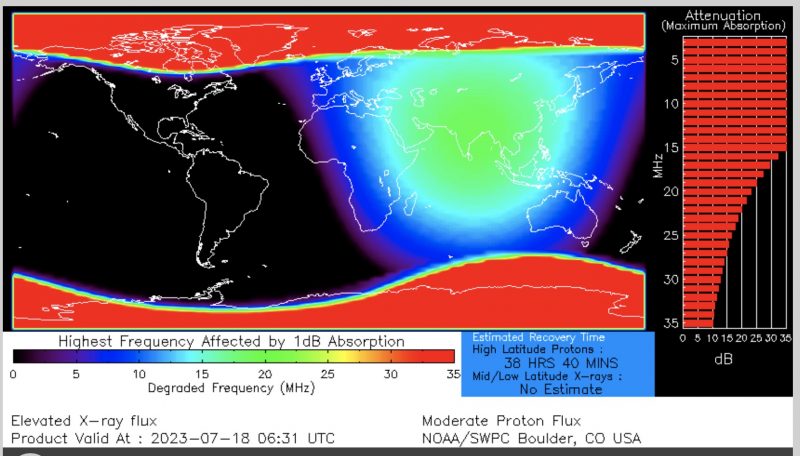
Sun activity for July 17, 2023: CME or CMEs arrive, sun action continues
The shock wave from a coronal mass ejection CME arrived at Earth at 19:20 UT on July 16. The arrival was earlier than anticipated. But it is not clear if the CME (or CMEs) was (were) just faster, or if it was from a different CME than anticipated. There were several events and the available imagery was limited, making a definitive determination difficult. So this could have been due to the predicted cannibal CME (see yesterday’s entry, below) or one of the other events over the past few days. The arrival disturbed the geomagnetic field enough to cause a G1 (minor) geomagnetic storm at 23:59 UT on July 16. The storm lasted for a few hours, but was otherwise unremarkable. AR3363 has almost rotated out of view but not without giving us an M4 flare.
Last 24 hours: Sun activity is moderate with two M flares. The largest event was an M4.0 from AR3363 at 17:36 UT. This caused an R1 radio blackout over the sun-facing side of Earth. The sun also produced 20 C flares between 11 UTC yesterday and 11 UTC today. AR3372 has not lived up to its beta-gamma-delta magnetic complexity while the simpler AR3373 produced the most of the C flares. There has been a lot of continued jet and ejecta action from AR3363 along with a few scattered small filament eruptions on the disk. An unnumbered region on the southeast limb (edge) looks promising so we wait to see what it brings. The sun currently has five labeled active regions on its Earth-facing side.
Sun activity for July 16, 2023: Cannibal CME and backside activity
The July 14 dark spray coronal mass ejection (CME) event is expected to overtake a July 15 CME. This is often called a cannibal CME. Neither event has a strong Earth-directed component. But the interaction has a good chance of knocking more of the plasma cloud into the sun-Earth line. If it happens, it would create a stronger Earth-directed component (stronger than zero). And that could means auroras. Meanwhile, on the sun, sunspot region AR3363 has kept its delta region. And now the previously active AR3372 has developed more magnetic complexity, a beta-gamma-delta configuration. The more complex the sunspot, the greater the potential for large flares. On the backside of the sun, a large region is still indicated by heliosiesmology. The region may be the origin of several (at least three) large CME related waves from the backside. These are apparent in the SUVI imagery on the west limb (edge) of the sun.
Last 24 hours: Sun activity is moderate with an M1.1 flare from AR3372 at 8:16 UTC on July 16. This flare caused an R1 radio blackout over the sun facing side of Earth. The sun also produced 14 C flares between 11 UTC yesterday and 11 UTC today. The sun currently has six labeled active regions on its Earth-facing side.

Sun activity for July 15, 2023: Spectacular dark filament eruption
AR3370 has grabbed our attention, launching a dark filament that fanned out across the solar disk. The region had been rather inactive until it released a C8.8 flare around 18:30 UTC on July 14. This was immediately followed by the dark filament eruption from the eastern side of the region. This created a dark spray that fanned out toward the west. The spray was dark because the filament material was much cooler than the surrounding material. The resulting coronal mass ejection (CME) likely has an Earth-directed component, but we await further analysis. We also saw a Type II radio burst from an M2.2 flare by AR3372, which is indicative of a CME. This event may also have an Earthward component, and analysis is ongoing. Stay tuned!
Last 24 hours: Sun activity is moderate, with an M2.9 flare from AR3363 along with an M1.1 and an M2.2 back-to-back from AR3372. The sun also produced 19 C flares between 11 UTC yesterday and 11 UTC today. The M2.9, which was fired at 7:21 UTC on July 15, caused an R1 (minor) radio blackout over southeast Asia and the Indian Ocean. AR3363 was the day’s leading flare producer, with the M2.9 and ten Cs. The sun currently has eight labeled active regions on its Earth-facing side.
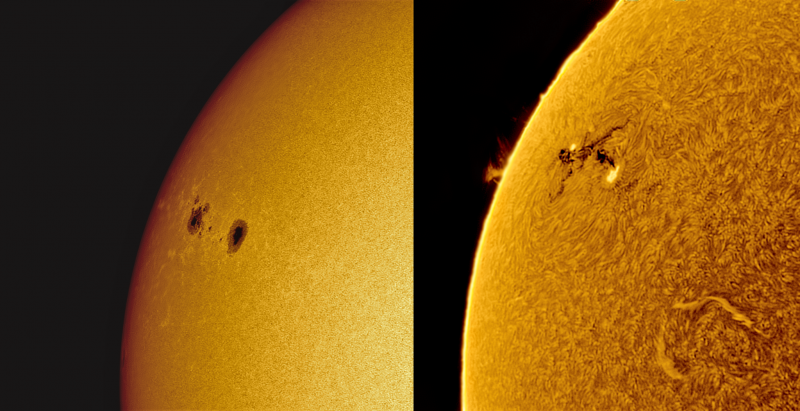
Sun activity for July 14, 2023: Anniversary of the Bastille Day event
Flaring quantity has dropped, with only 10 produced over the past day, but an M2.1 flare by AR3372 has raised the activity level to moderate. We’ve been observing a fiery northwest limb, where a filament erupted in the vicinity of AR3361. This region will soon rotate out of view. Elsewhere, the largest region on the sun, AR3363, has been showering space with surges and jets of solar plasma. While we’ve seen many coronal mass ejections (CMEs) produced, none have been Earth-directed. We have seen some full halo CME events, but these have largely been from the sun’s back side. Helioseismology shows a large active region on the other side of the sun, which is the likely culprit. Today is the 23rd anniversary of the famous (or perhaps infamous) Bastille Day event of 2000. The X5.7 flare and powerful solar particle event were captured by the SOHO and TRACE spacecraft. This event was not only spectacular, but it caused many problems for satellites and communications. It even did some damage to SOHO, our solar watchdog. And the resulting geomagnetic storm created auroras seen as far south as Texas in the United States. This was definitely one to remember!
Last 24 hours: Sun activity is moderate with the production of an M2.1 flare by AR3372. This occurred at 19:20 UTC on July 13. The sun also produced nine C flares between 11 UTC yesterday and 11 UTC today. The M flare caused an R1 (minor) radio blackout over Baja California and the west coast of Mexico. AR3372 was the day’s leading flare producer, with four Cs and the M flare. The sun currently has eight labeled active regions on its Earth-facing side.
Sun activity for July 13, 2023: Calm after AR3372’s storm
After arriving with a bang (or seven) yesterday, M flare-producing AR3372 has calmed down today, dropping activity from high to low. Now that it is more fully in view, we can see that AR3372 has only a simple magnetic complexity. We assume it was more complex when it was producing the M flares, and that it lost its complexity after shedding the energetic flares. We’ll watch and see if it regains some of its potential. Elsewhere, AR3361 has reached the central meridian in the sun’s southern hemisphere. This puts it into a more geoeffective location, meaning that any coronal mass ejections (CMEs) it releases will be heading our way on Earth. A filament in the area erupted yesterday, unleashing a full halo CME. The region has continued to produce surges and sprays (see the SDO 304 angstrom imagery below), but no new CMEs were observed in SOHO’s LASCO C2 or C3 coronagraphs.
Last 24 hours: Sun activity has returned to low. The sun produced 15 C flares between 11 UTC yesterday and 11 UTC today. The largest was a C9.4 flare from AR3372 at 5:21 UTC on July 13. AR3372 produced the most flares, with 11 Cs. Most sunspot groups currently on the sun have relatively simple magnetic complexity, except for AR3363 with its beta-delta configuration. The sun currently has 10 labeled active regions on its Earth facing side, but in the past day that number momentarily reached 12.
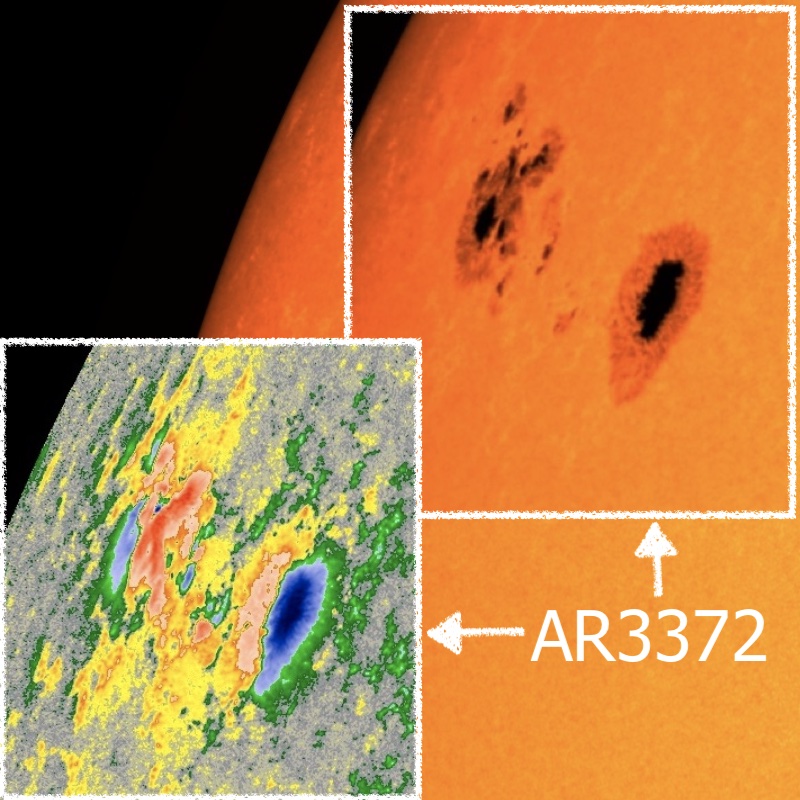
Sun activity for July 12, 2023: Newcomer AR3372 brings a flurry of flares!
A new active region on our sun has arrived in style! AR3372 roared over the northeast limb (edge) with seven M flares in the past 24 hours. Three of those flares were above the M5 threshold, bringing sun activity levels to high. Not to be outdone, AR3361, AR3366, and AR3368 each gave us an M flare during the period, but they were no match for AR3372. Because it’s only just coming into view, the region is too foreshortened to fully characterize its size and complexity, but all indications suggest it’s an impressive sunspot group. Elsewhere, we observed a number of erupting filaments producing coronal mass ejection (CMEs). At the moment, none of the events have an obvious Earth-directed component. A full halo event was observed by the SOHO spacecraft’s LASCO C2 and C3 instruments at around 16:48 UTC on July 11, but it appears that the explosion occurred on the far side of our sun.
Last 24 hours: Newcomer AR3372 on the northeast limb (edge) raised sun activity to high with the production of seven M flares over the past day. Between 11 UTC yesterday and 11 UTC today we observed a total of ten M flares and 11 Cs. The largest was an M7.0 blasted at 8:55 UTC by AR3372 on July 12. Here’s the breakdown of the M flares, with all times in UTC:
M2.0 at 14:35 by AR3372 on July 11
M1.2 at 16:12 by AR3372 on July 11
M6.8 at 18:08 by AR3372 on July 11
M1.0 at 19:29 by AR3372 on July 11
M5.8 at 22:15 by AR3372 on July 11
M1.3 at 23:37 by AR3368 on July 11
M1.4 at 0:31 by AR3366 on July 12
M1.4 at 4:50 by AR3372 on July 12
M1.4 at 5:14 by AR3361 on July 12
M7.0 at 8:55 by AR3372 on July 12, the largest.
Every M flare produced a radio blackout on the sunlit side of our planet, and the largest Ms created R2 (moderate) radio blackouts:
M6.8 at 18:00, affecting an area over México and the U.S.
M5.8 at 22:15, affecting an area over Hawaii.
M7.0 at 8:55, affecting an area over Saudi Arabia and Persian Gulf.
The leading flare producer of the period was AR3372, which released 13 flares: seven Ms and six Cs. The sun currently has 11 labeled active regions on its Earth-facing side.
Sun activity for July 11, 2023: Who fired the flare, AR3358 or AR3366?
Sunspot AR3358 is back in business … or is it? Yesterday, we noticed a return of this rather faint active region, which looked too small to produce larger flares. So we were then surprised to read that it had fired off an M flare yesterday evening. However, all was not as it seemed. After checking through the data and with other experts, it appears that the true culprit was actually AR3366, not AR3358. This is what astrophysicists call source confusion; when you have many players bunched together in the field, it can be hard to tell who did what. Elsewhere on the sun, we observed a spectacular prominence on the northwest limb (edge). The blast was registered by the SOHO spacecraft’s LASCO C3 instrument as a partial halo coronal mass ejection (CME). Since it originated from the back side of the sun, there’s a chance that it came from our old friend AR3354. We can’t be sure without the ability to observe the other side of the sun. But, using helioseismology, we have been able to detect a very large sunspot on the sun’s reverse where AR3354 should be, so there’s a good chance that this was the case. Perhaps the region will make it back around for another exciting transit across the Earth-viewed sun. Stay tuned!
Last 24 hours: Sun activity is moderate with the production of an M1.5 flare by AR3366. The flare occurred at 22:18 UTC on July 10. We observed an increase in flaring productivity over the past day: a total of 22 flares were produced between 11 UTC yesterday and 11 UTC today, of which one was an M flare and the rest were Cs. AR3366 produced the second most flares, with nine including the M flare. The most prolific producer was an as-yet-unnumbered region on the northeast limb, which produced ten of the 22 flares. Shortly after the M flare, an R1 (minor) radio blackout affected an area over Hawaii. At the time of this writing, the sun has ten labeled active regions, but momentarily during the day it reached 11. A newcomer has come into view on the southeast limb (edge), now numbered AR3370.
Sun activity for July 10, 2023: False claims about auroras spread
An article circulating on CBS News, AP News and other media outlets suggests (erroneously) that the middle of this month – July 2023 – is going to be an exceptional time to see auroras in the U.S. The suggestion is that the auroras will be due to geomagnetic storms expected around July 13. This information is false. There are no observations of solar activity that would indicate an exceptional auroral display in mid-July 2023. The article points to predictions from the University of Alaska Fairbanks Geophysical Institute’s aurora forecast. We use that source, too; it’s a good source. But the predictions for July 13 have no support from observations. The article also points out (correctly) that auroras occur more frequently around equinoxes. And so they do. But the article then states (incorrectly) that equinoxes are the time of most daylight. Wrong. The solstices, not the equinoxes, bring the longest days. The equinoxes are when night and day are roughly equal. There are several other inaccuracies or misleading statements in these fast-spreading articles about auroras in mid-July 2023. To keep up with the best times to see auroras, stay tuned to this page. We try to sift through all the data from the noise, to give you the most clear and accurate answers that science can provide.
Last 24 hours: Sunspot region AR3358 released a surprising M2.4 flare, shortly before decaying away. The region was very small and non-complex, so a moderate-to-large flare wasn’t expected. The flare erupted early today (3:39 UTC on July 10, 2023) and an associated filament eruption produced a coronal mass ejection (CME) off the sun’s southwest limb (edge). Thanks to this flare, sun activity is now considered moderate. There were 18 C flares and an M flare over the past 24 hours (11 UTC yesterday to 11 UTC today). The sun currently has 10 numbered sunspot regions. AR3358, which was just southwest of AR3366, has lost is number since it produced the M2.4 flare and afterwards decayed. AR3368 and AR3369 just emerged. These regions, along with AR3360 and AR3367, have grown while the rest have remained stable or decayed. By the way, the largest region, AR3363, is still visible without magnification from here on Earth if you are wearing the proper eye protection.
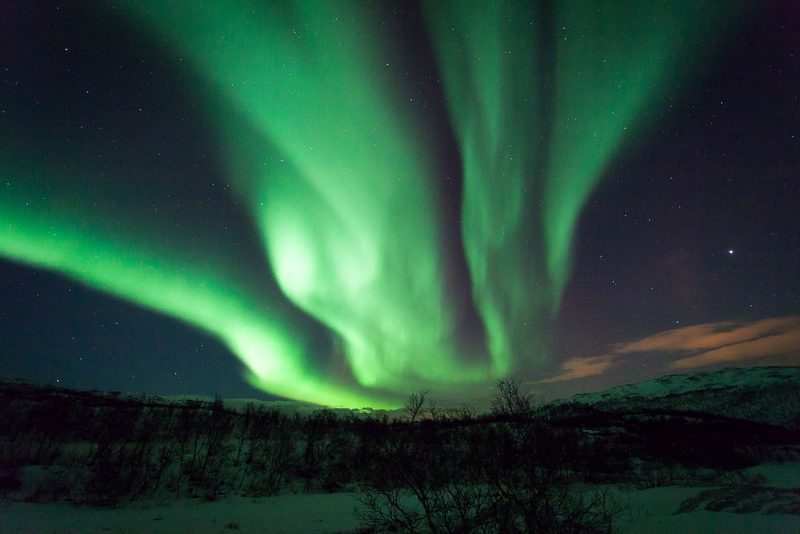
Sun activity for July 9, 2023: A calm day in the neighborhood
Today is a relatively calm day on the sun. However, looking at the four panel animation of the past 24 hours of our star shows that nearing solar maximum, even a calm day has a lot happening. In the red 304 angstrom images, we can see prominences on the limb (edge), darker filaments on the solar disk, and the bright active regions over sunspots. The 171 angstrom images show large solar magnetic loops, including one on the eastern limb that goes across the equator. It’s aptly called a transequatorial loop. The 193 angstrom images highlight the dark coronal holes, one in the northeast and one in the southeast. The last set of white light – or continuum – images shows sunspots that sit in the photosphere, under the bright active regions in the first three images.
Last 24 hours: Sun activity is low. There were 22 C flares produced between 11 UTC yesterday and 11 UTC today. The largest was a C5.6 flare from AR3366 at 23:37 UTC on July 8. AR3361 was the past day’s lead flare producer with eight C flares. The sun currently has ten numbered sunspot regions.
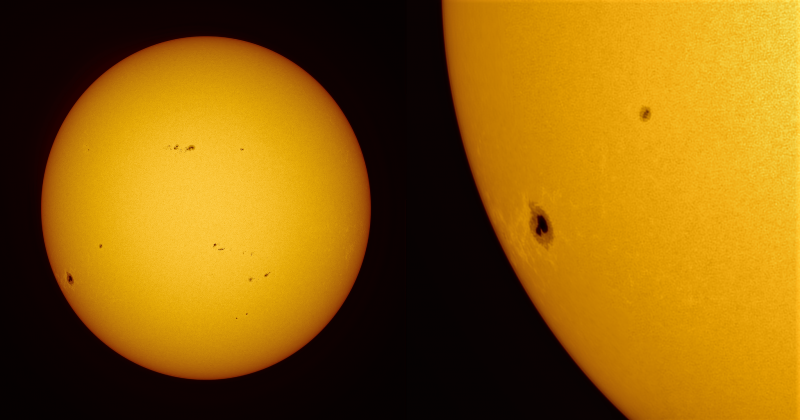
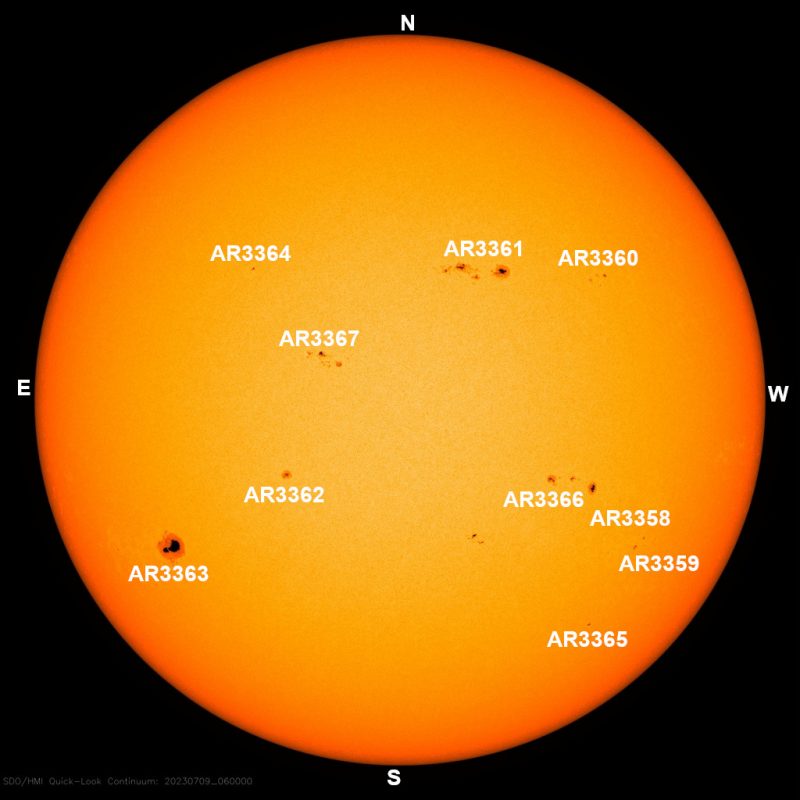
Sun activity for July 8, 2023: 3 sunspot regions hold promise
Activity on the sun has calmed for now with the departure of AR3354, but three regions hold promise. The largest region, AR3363, is visible without magnification from here on Earth if you are wearing the proper eye protection. AR3361 is providing the most flaring activity at the moment and is showing a beta-delta magnetic configuration. This could be the sign of larger flaring to come, including M or possibly X flares. The last region of note is AR3366, sitting large in the southwest. With the other sunspot regions remaining stable or decaying, we’re looking at these three for the next round of action on the sun. Geomagnetic action could be on its way, too; there are now two coronal holes on the earth-viewed solar disk, whose fast solar wind may give us some exciting geomagnetic activity at Earth soon. In other news, the LASCO C3 instrument on the SOHO spacecraft caught a parting shot of Mercury as it leaves its field of view. Check it out below.
Last 24 hours: Sun activity is back to low. There were only 11 C flares produced between 11 UTC yesterday and 11 UTC today. The largest was a C4.2 flare from AR3361 in the northeast quadrant at 1:44 UTC on July 8. This sunspot, AR3361, was the past day’s lead flare producer with five C flares. The sun currently has nine numbered sunspot regions.


Sun activity for July 7, 2023: Unbelievable! One more M flare by AR3354
Just when we thought it had finally departed, sunspot AR3354 showed us it had some more flaring up its sleeve! Yesterday’s M flare was not its last, as we had thought. From behind the solar limb (edge), AR3354 released an M1.1 flare which peaked at 11:16 UTC on July 6. However, the flare was probably larger, as our view of the event was partially blocked by the sun’s horizon. Meanwhile, the coronal mass ejection (CME) from July 4 has arrived. We observed a rise in activity on Earth’s magnetic field this morning, and the threshold for a G1 (minor) geomagnetic storm is expected to be reached later today. Auroras should be on the way!
Last 24 hours: Sun activity is moderate. Two M flares were produced between 11 UTC yesterday and 11 UTC today. One was the M1.1 flare by AR3354 that we mentioned above. The second, and largest, was an M4.0 from AR3359 at 6:29 UTC on July 7. The sun also produced eight C flares for a total of 10 flares for the day. After each M flare there was a corresponding R1 (minor) radio blackout. The M1.1 flare affected an area over the Atlantic Ocean, while the radio blackout from the M4.0 affected an area over Nepal and Mount Everest. The sun currently has eight numbered active regions. There are a couple of newcomers: AR3363 on the southeast limb (edge), which is looking pretty big, and tiny AR3364 showing faintly on the northeast quadrant.
Sun activity for July 6, 2023: M flare, CME arrival early July 7
Sunspot AR3354 left with a final hurrah: an M1.0 flare. The blast occurred late on July 5, 2023, at 18:58 UTC while this active region was partially out of view. At the moment of this writing (around 11 UTC), AR3354 has completely disappeared behind the solar horizon on the northwest. But it’s still making its presence known. Turning back to Earth, the coronal mass ejection (CME) associated with a flare from AR3359 around 4 UTC on July 4 should arrive early July 7. NOAA has issued a G1 (minor) geomagnetic storm alert. Aurora chasers, get ready to bring out your cameras and equipment! And don’t forget to share your beautiful photos with us. Submit them to EarthSky Community Photos. Stay tuned for more sun news.
Last 24 hours: Sun activity is moderate today with the production of an M1.0 flare by sunspot AR3354 before it completely departed. The explosion occurred at 18:58 UTC on July 5 with the giant sunspot almost entirely behind the northwest limb (edge). Shortly after the flare an R1 (minor) radio blackout occurred over México. Total flaring production during the past day between 11 UTC yesterday and 11 UTC today was 18 flares, 17 Cs and the M1.0 flare. AR3354 was the lead flare producers with eight flares including the M1.0. Just before this writing it gave a C2.9 flare at 09:52 UTC on July 6. The sun has six labeled active regions, with a large newcomer, AR3362, rotating into view on the southeast limb (edge).
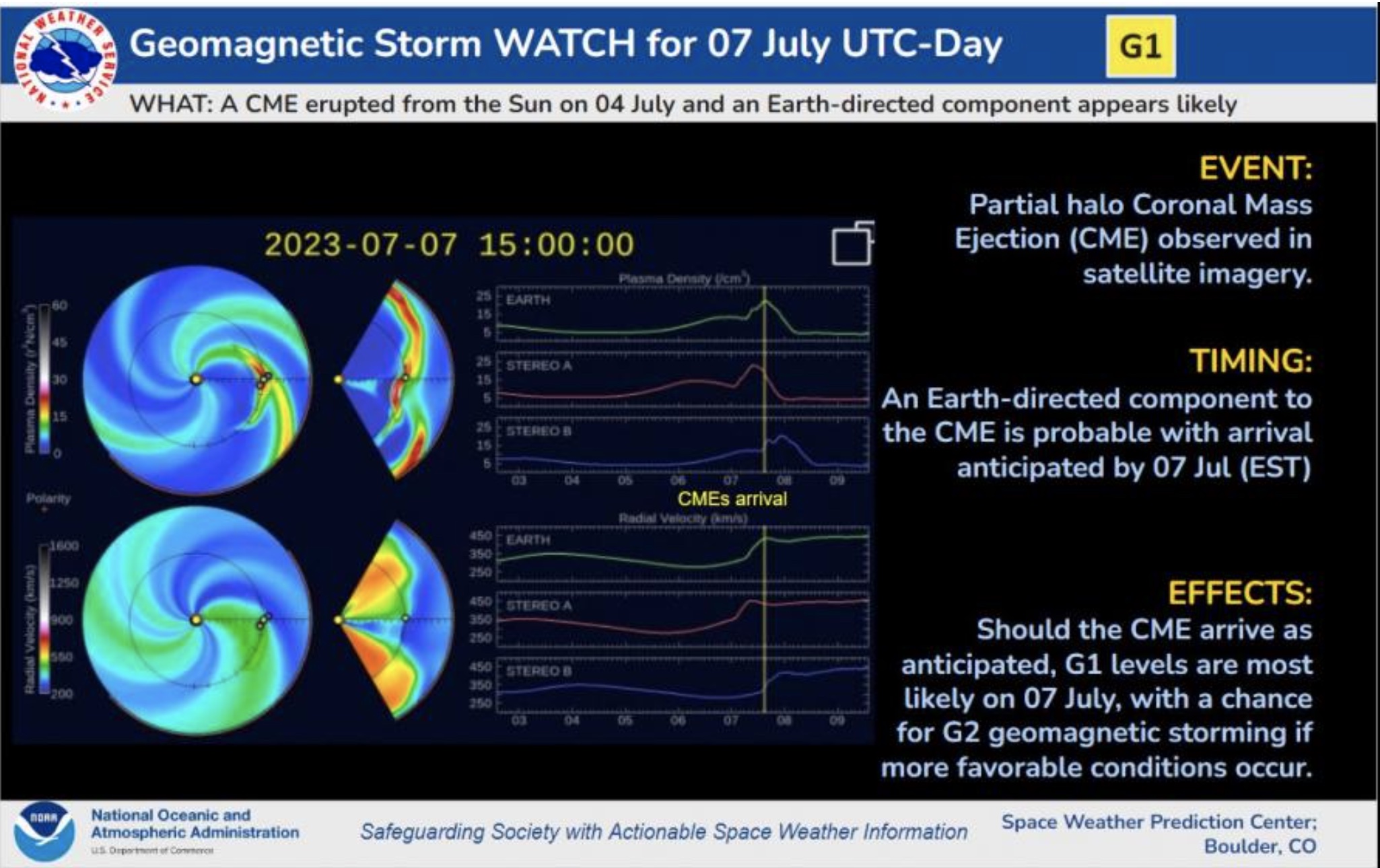
Sun activity for July 5, 2023: Prolific AR3354 departs, 2 CMEs on the way
Sun activity has reached moderate with an M flare from prolific flare-producer AR3354, just as it’s departing from view on the northwest limb (edge). Meanwhile, over on the southeast limb, we’ve seen some beautiful prominences and loops coming from behind the horizon. That means there’s an active region heading our way. Will it continue where AR3354 left off? Let’s wait and see. Meanwhile, two coronal mass ejections (CMEs) fired in the past two days have been confirmed to be Earth-directed. The first arrival is predicted for late July 6 to early July 7, likely bringing a G1 (minor) geomagnetic storm. Get more detail below.
Last 24 hours: Sun activity is moderate today. Before departing, the giant sunspot group AR3354 – which has brought us an X flare, several Ms and many Cs – released an au revoir M1.5 flare at 12:35 UTC on July 4. Shortly after the M flare, an R1 (minor) radio blackout registered, affecting an area over Morocco on the northwest coast of Africa. AR3354 was, once again, the lead flare producer of the past day. It fired 16 flares out of the 19 produced between 11 UTC yesterday and 11 UTC today. Its output included the M1.5, along with 15 Cs. AR3354 is showing some decay as it departs, and its current position almost over the northwest solar horizon makes it difficult to give a complete classification. The sun currently has six numbered active regions, including newcomer AR3361. This region appeared east of AR3360 on the northeast solar quadrant.
Sun activity for July 4, 2023: Solar Cycle 25 surpasses Solar Cycle 24’s peak
Solar Cycle 25 has exceeded expectations, with its June 2023 sunspot count surpassing the maximum reached by Solar Cycle 24. A couple of weeks ago we reported that the sun had 16 labeled sunspots on its Earth-facing side, a high point for the year. We mentioned that this high point could help to record a peak for Solar Cycle 25, and today it is confirmed: the sunspot count for June 2023 reached 163, beating Solar Cycle 24’s highest monthly value of 146 back in February 2014. We have not seen a count like this since September 2002. This points to Solar Cycle 25 being stronger than its predecessor and stronger than predicted. Solar Cycle 25’s current levels are a year and a half to two years ahead of the forecast. And we have not reached the solar maximum yet … So, more action is on its way!
Last 24 hours: While Solar Cycle 25’s activity is exceeding expectations, activity on the sun today is low, with only 19 C flares produced between 11 UTC yesterday and 11 UTC today. The largest was a C8.9 from sunspot AR3360 at 21:12 UTC on July 3. The past day’s lead flare producer was AR3358, with seven flares. The previous leader, yesterday’s X1.1 producer AR3354, fired off four C flares. It’s showing decay and is almost over the edge on the northwest limb, but it still retains its delta configuration. Will it release another powerful flare before departing? We’ll see. The sun currently has six numbered active regions on its Earth-facing side. Stay tuned!
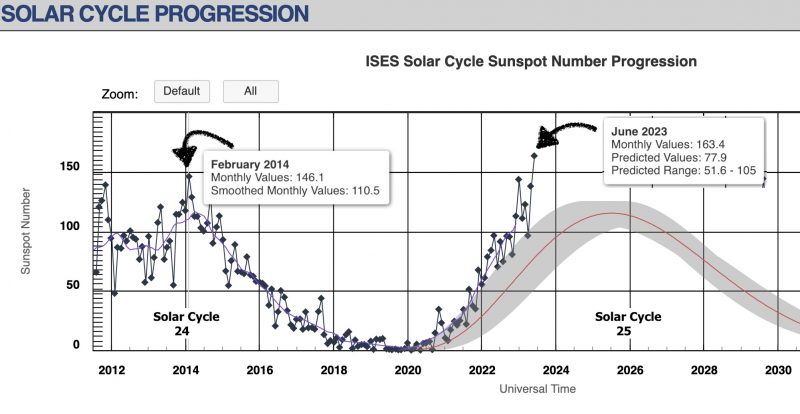
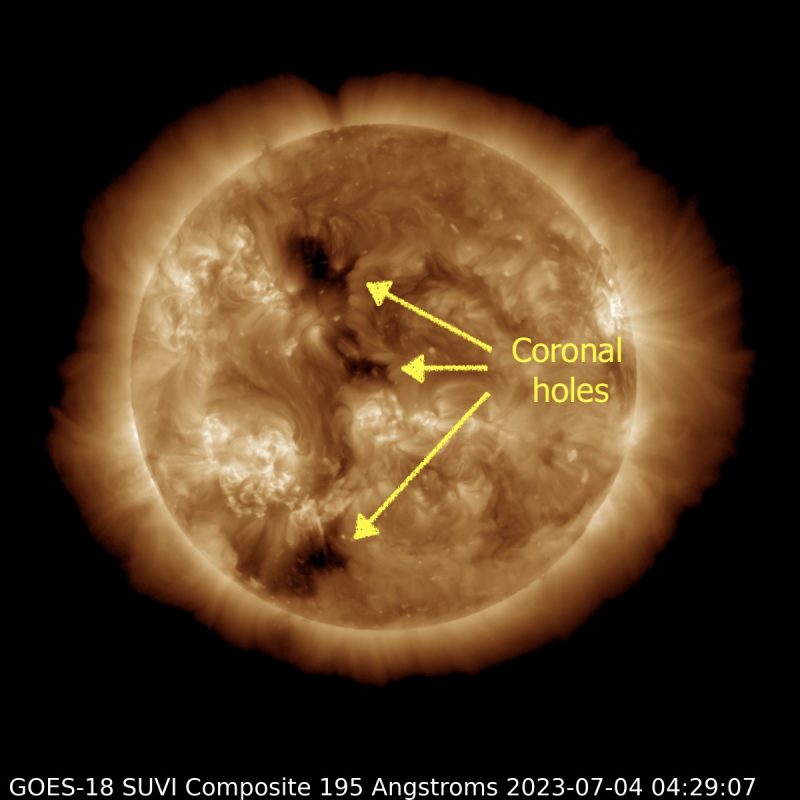
Sun activity for July 3, 2023: The sun releases an X1.1 flare
Sun activity reached high levels thanks to an X1.1 flare from the giant region AR3354. No fear, however, as it has not produced any ejecta that is Earth-directed. AR3354 has kept its magnetic complexity of beta-gamma-delta, and its size has increased to an area equivalent to the surface area of approximately seven Earths. Although the eruption did not appear to produce any plasma ejecta, there were some very tall loops after the flare. These are appropriately called post-flare loops. The region will soon rotate out of view, but don’t count it out. Even once it’s no longer visible, we could still see large eruptions from around the limb (edge). The combination of the region’s magnetic configuration and having already produced an X flare raised the chances for another X flare from 10 to 25%. This is the 18th X flare of SC25 (solar cycle 25) so far, while SC24 had 14 X flares total. It’s getting interesting, and we most certainly have a lot more activity to look forward to over the next several years. Stay tuned!
Last 24 hours: Sun activity is high with an X1.1 flare from AR3354 at 22:54 UTC on July 2, 2023. A total of 16 flares were produced including the X1.1 flare, an M1.4 from AR3358 at 6:43 UTC on July 3, 2023, along with 14 C flares. The X flare created an R3 radio blackout over the Pacific, and the M flare caused an R1 radio blackout over Asia. The sun currently has seven labeled active regions.
Sun activity for July 2, 2023: Surprise region turns up the action
Sun activity has again reached moderate levels, but it’s not because of AR3354. The surprise culprit of two M flares is AR3359. This region is fairly small and only has minor magnetic complexity, yet it gave us the M flares along with a lot of jet activity. We expected the next big eruption from AR3354, given that it has magnetic complexity with its beta-gamma-delta classification. We wait to see if AR3354 picks up, or if AR3359 will keep the action going. Or maybe both regions will kick it up a notch. You can still see AR3354 without any magnification, as long as you wear the proper eye protection. But you’ll have to catch it soon, as it’s now located on the northwest quadrant and will soon rotate out of view. Stay tuned!
Last 24 hours: Sun activity is moderate with 14 C flares and two M flares between 11 UTC yesterday and 11 UTC today. The largest event was an M2.1 flare from AR3359 on 2:29 UTC on July 2. The second largest event was an M1.1 from AR3359 on 22:07 UTC on July 1. Both flares produces R1 radio blackouts over the sun-facing side of Earth. AR3359 produced seven of the flares including the two M flares. The sun currently has six labeled active regions.
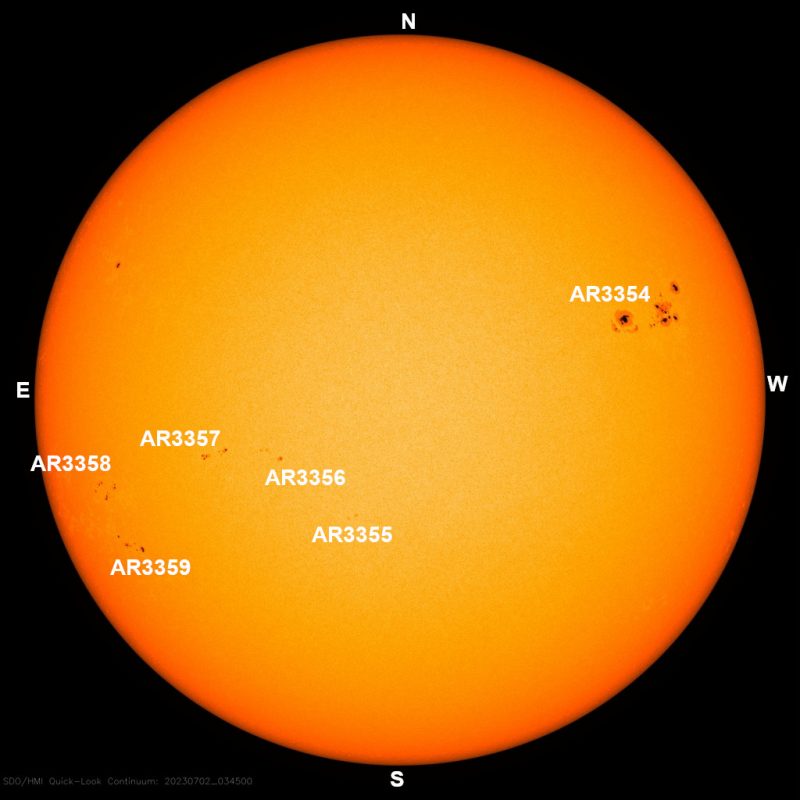
Sun activity for July 1, 2023: Meet the gentle giant AR3354
Today, while sun activity is back to low, gentle giant sunspot region AR3354 draws our attention. We saw it for the first time on Monday, June 26, when it emerged from nothing on the northeast solar quadrant. Within 24 hours it grew in size and magnetic complexity, developing its configuration from beta to beta-gamma-delta. The greater the magnetic complexity, the greater the potential for more powerful flares. It stands out as the largest sunspot on the Earth-facing side of the sun, close to the surface area of five Earths. You can still see it without any magnification, as long as you wear the proper eye protection. But you’ll have to catch it soon, as it’s now located on the northwest quadrant and will soon rotate out of view. It’s been the leading flare producer of the past week, with an output that included some M flares. So why do we call it gentle? Well, with its level of magnetic complexity, it has the potential for larger M flares and even X flares. Will it let loose some major flares before it departs? We shall see. Stay tuned!
Last 24 hours: Sun activity is back to low. We observed 14 C class flares between 11 UTC yesterday and 11 UTC today. The largest event was a C4.3 flare from AR3351, fired at 13:51 UTC on June 30. Leading flare producer AR3354 blasted out four C flares. Sunspot region AR3340 was just a step behind, with three C class flares. The sun currently has six labeled active regions.












